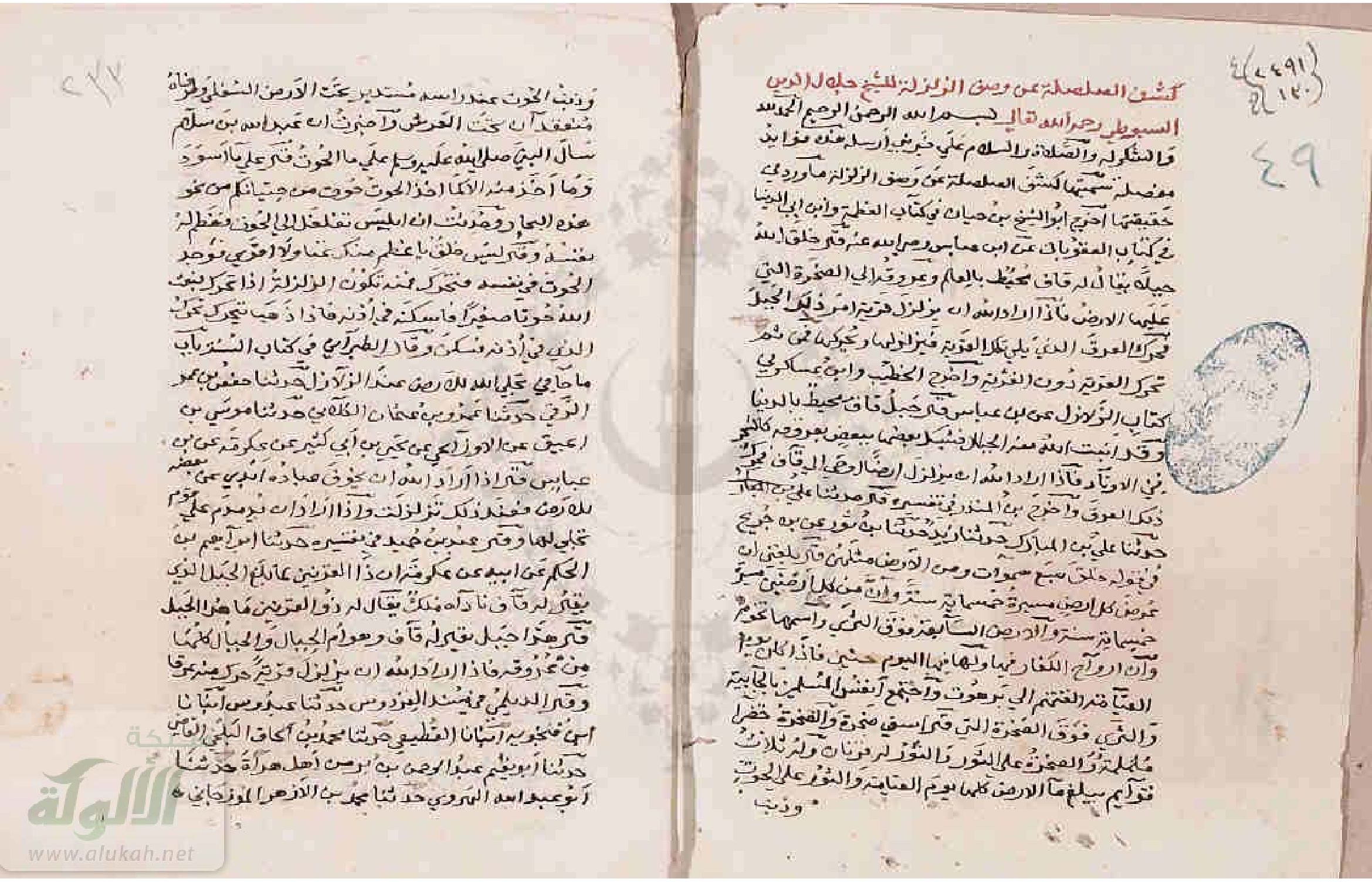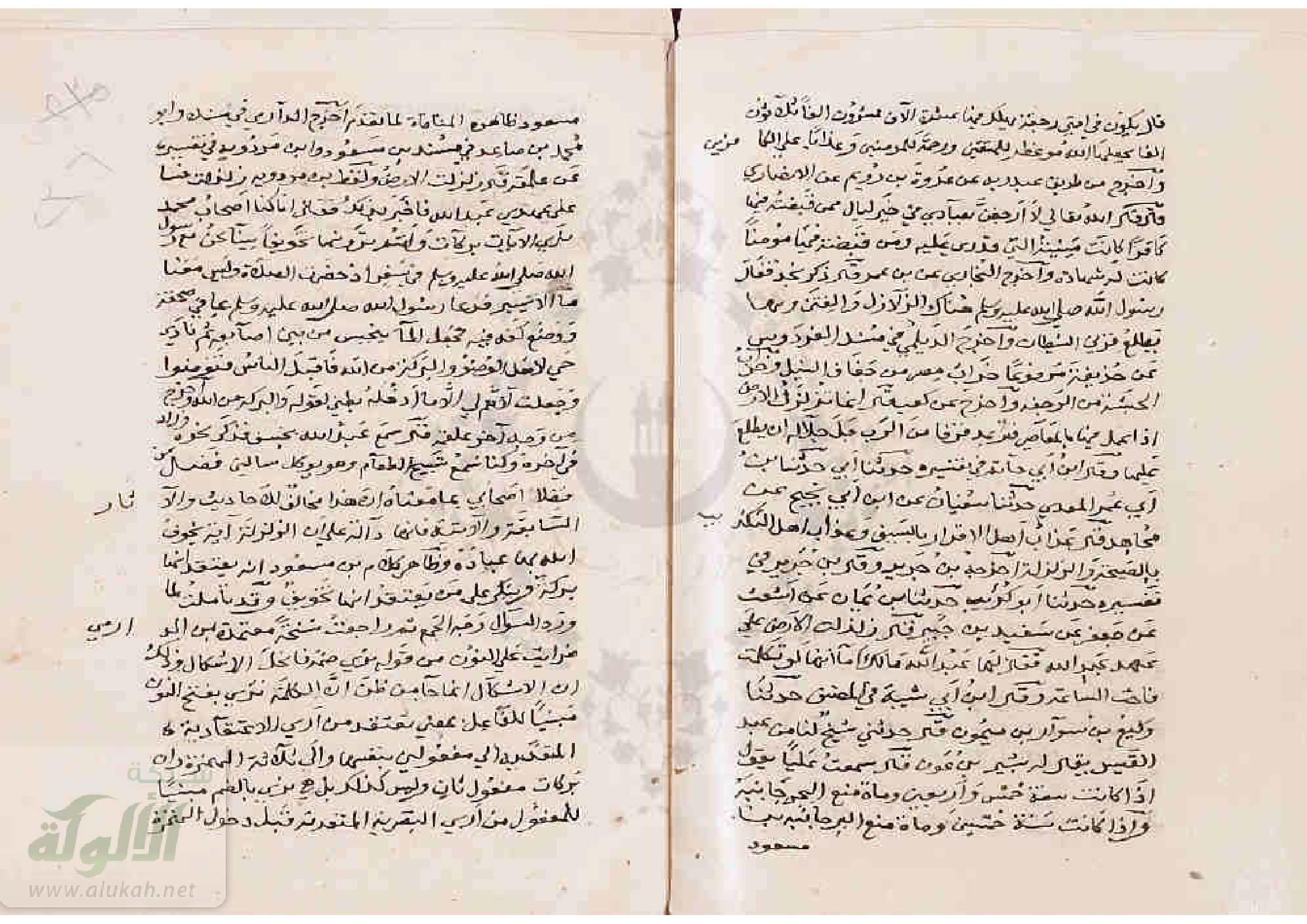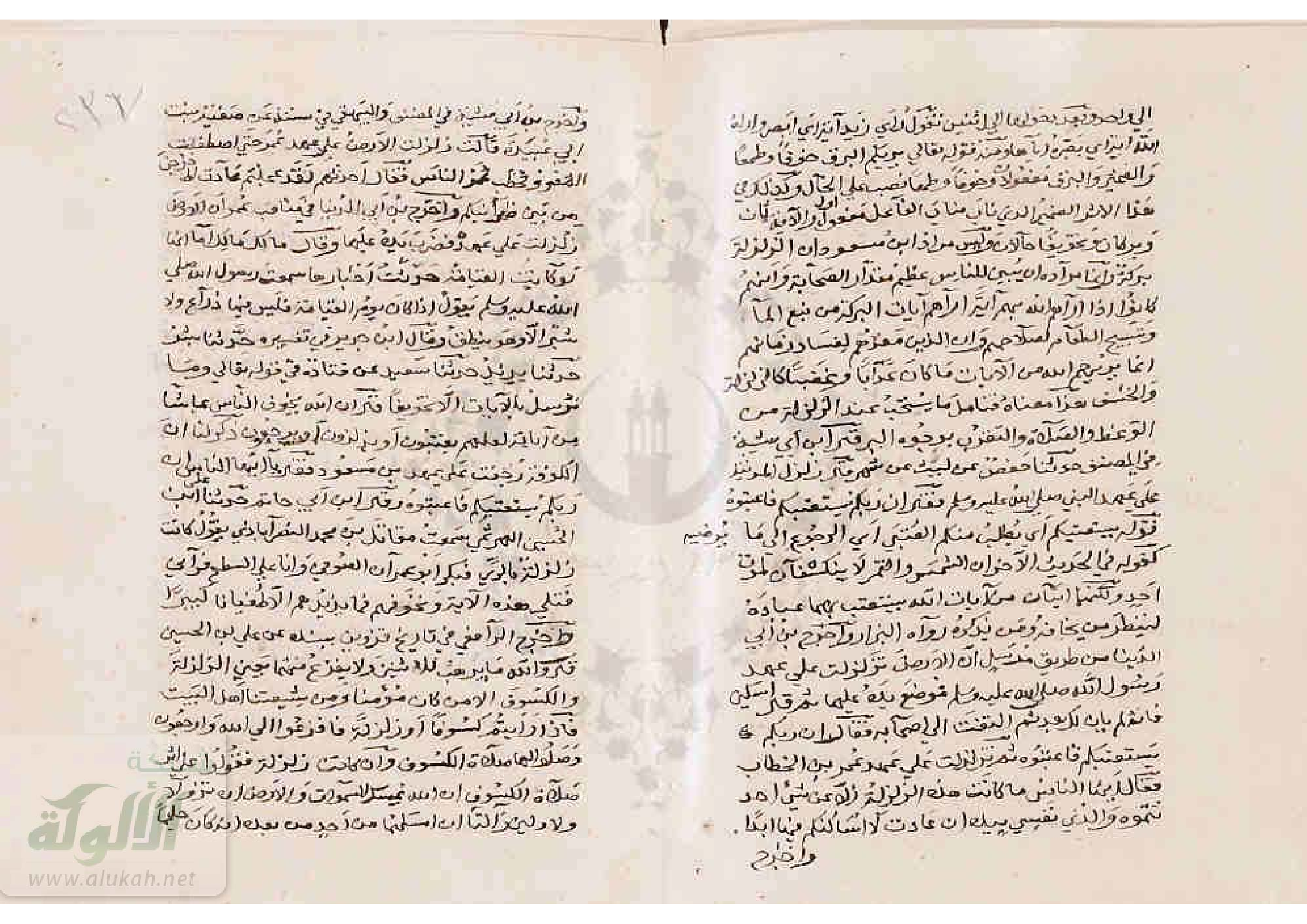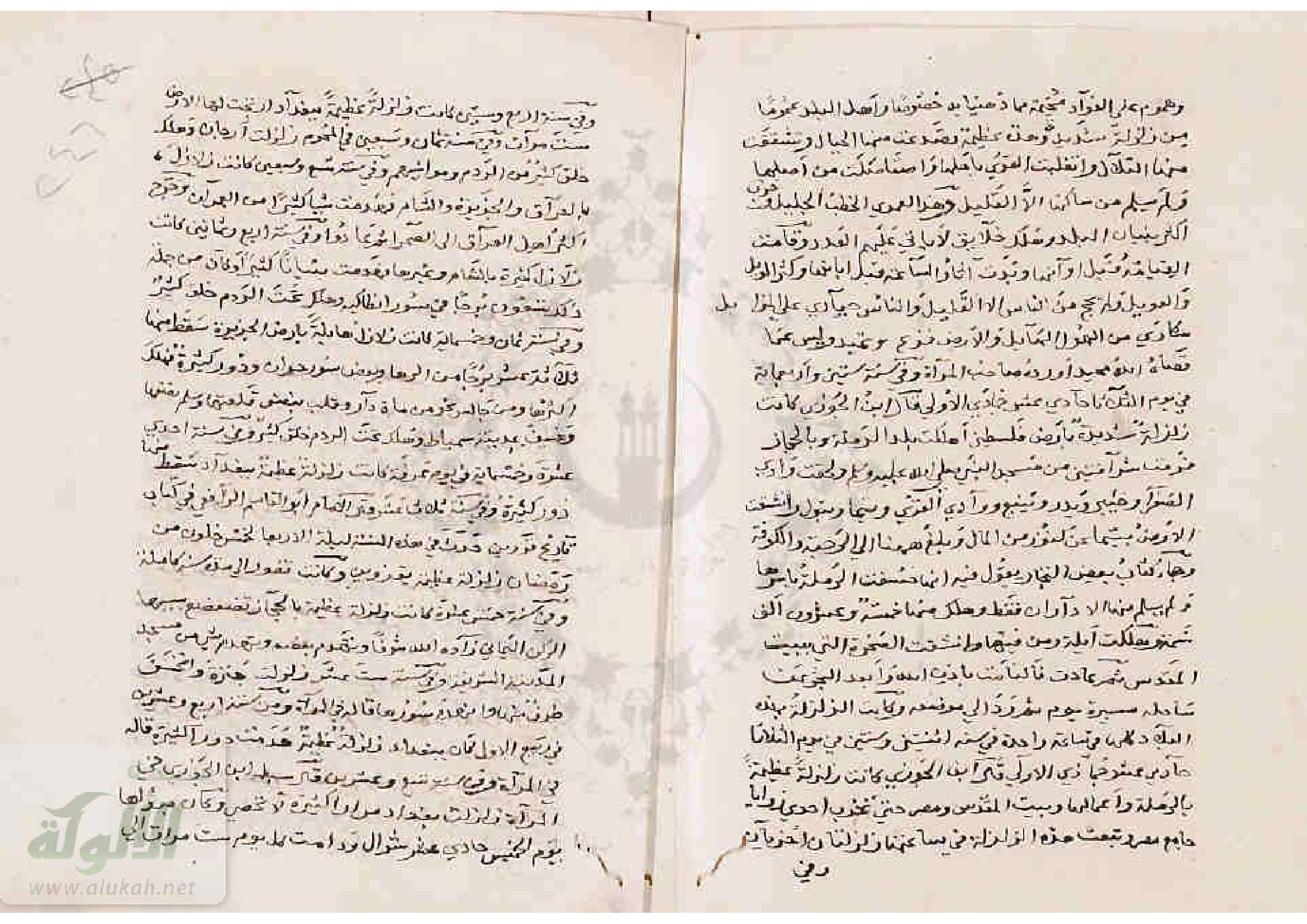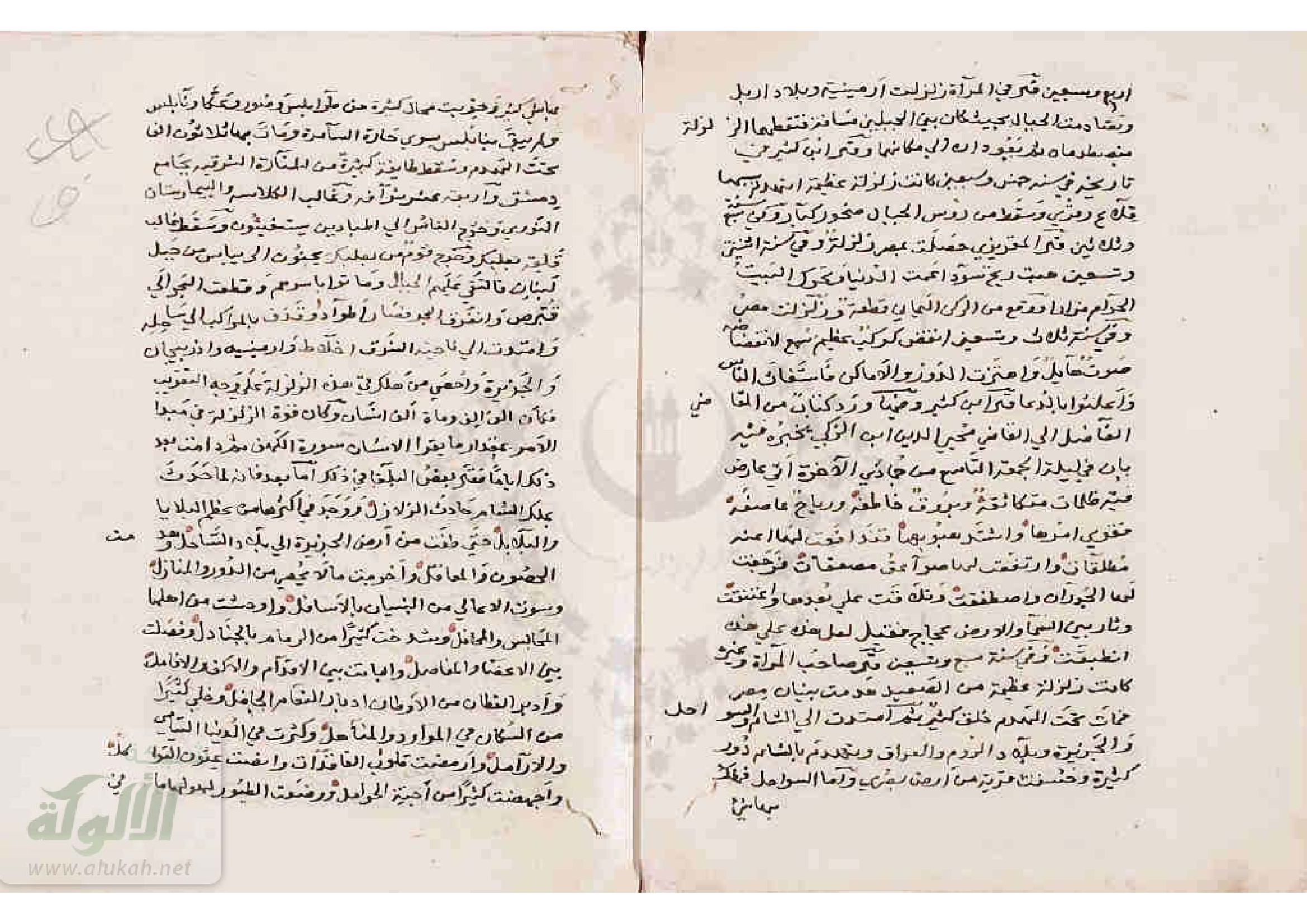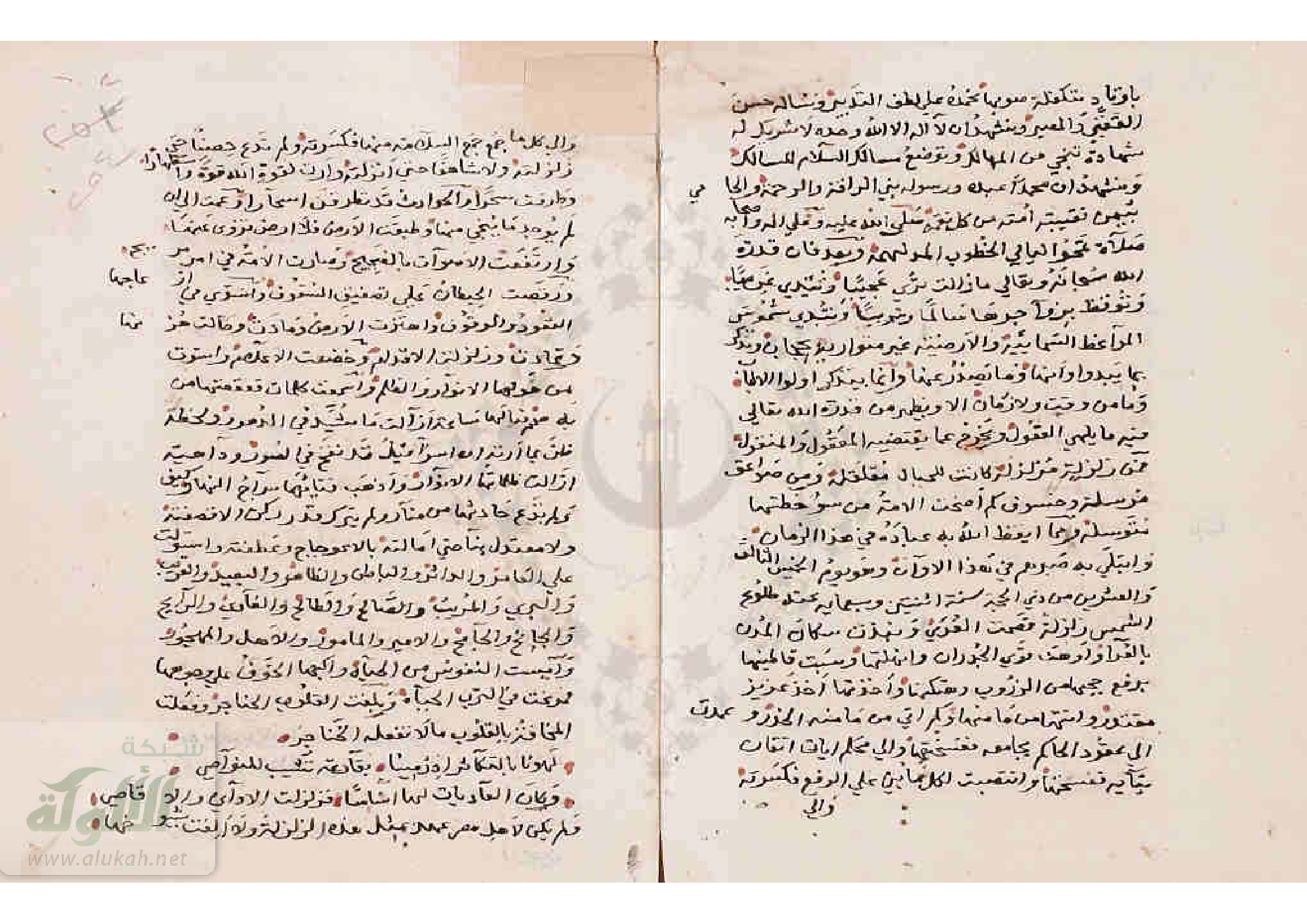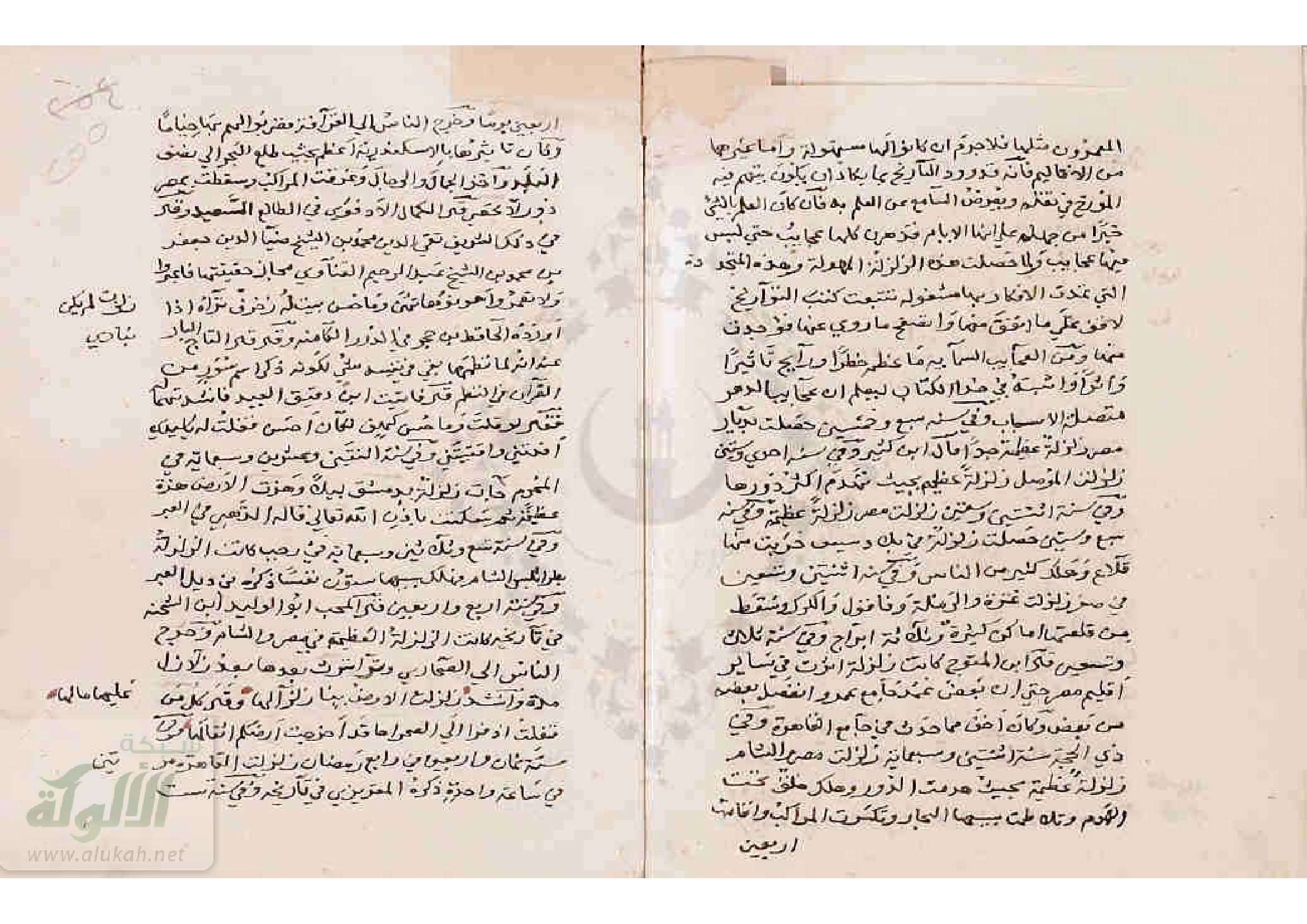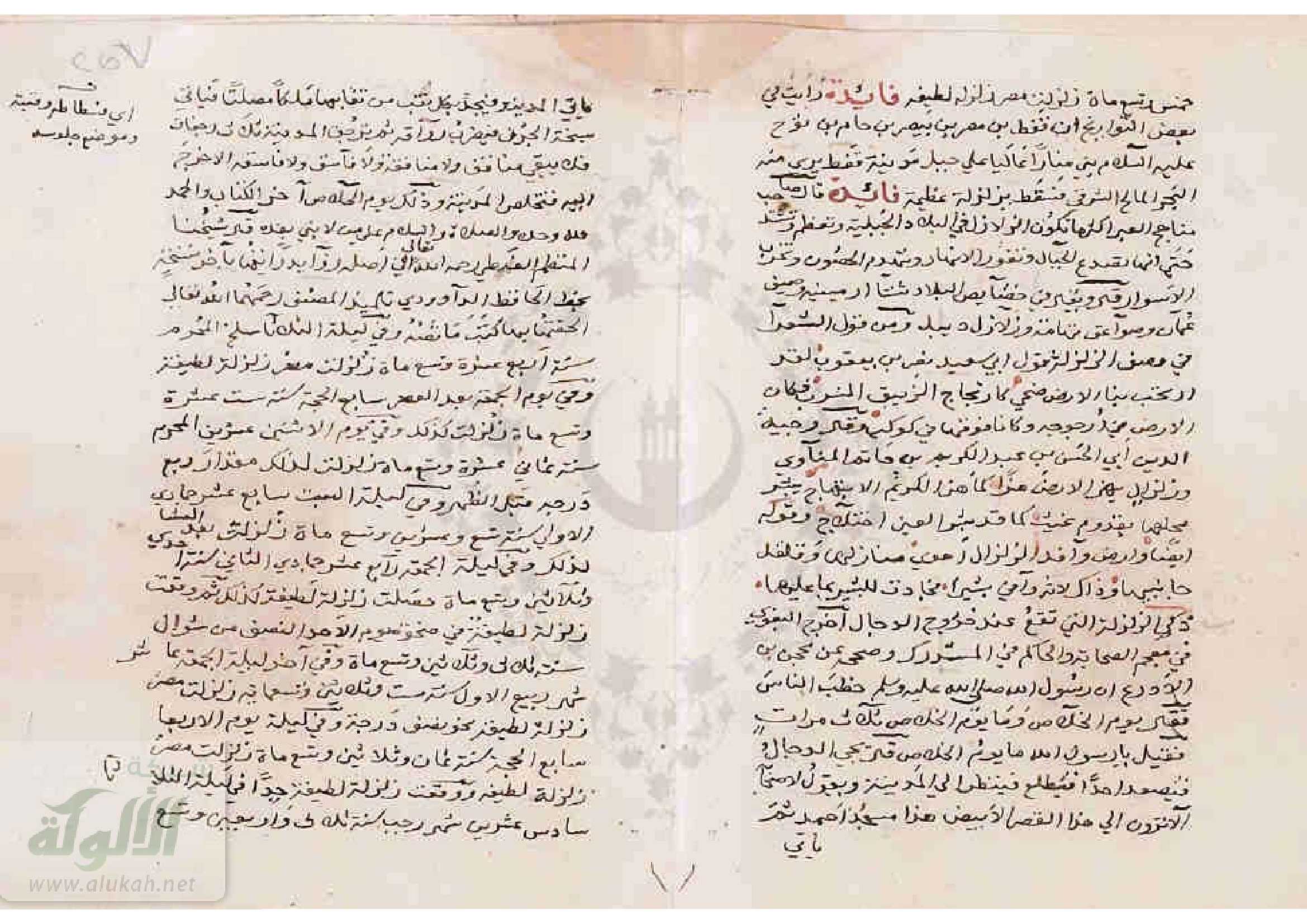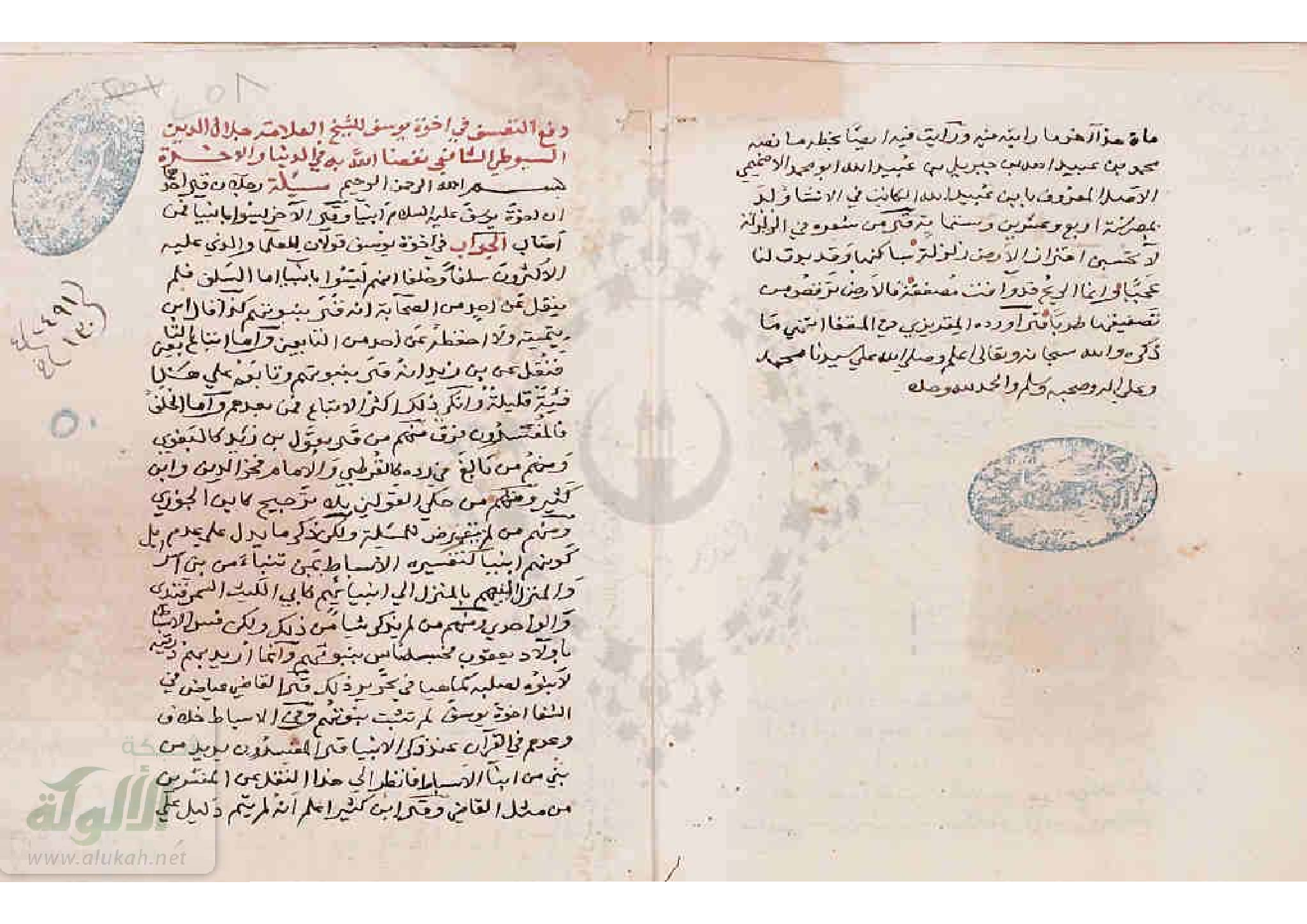Clearing up the Description of Earthquakes by Jalal al-Din al-Suyuti
كتاب كشف الصلصلة عن وصف الزلزلة by عبد الرحمن بن كمال الدين أبي بكر بن محمد سابق الدين خضر الخضيري الأسيوطي
Aliases
Aliases Arabic Al-Suyuti As-Suyuti Jalal al-Din al-Suyuti Abu 'l-Fadl 'Abd al-Rahman ibn Abi Bakr ibn Muhammad Djalal al_Din al-Khudayri Background and Biography Background and Biography
Events 9 December 1156 CE Aleppo Quake(s)
Excerpts English from Ambraseys (2009)
- from Ambraseys (2009)
During the night of the 22nd of the same month [551 Shawwal 22/ 8 December 1156] one or several earthquakes took place.(al-Suyuti 82/26).English from Sprenger (1843)
A.H. 552. In the night of 19th of Safr, a great earthquake took place which was followed by another shock ; a third one took place in the night of the 20th, and the following day in Syria. In the night of the 25th Jomada 1st, four shocks. In the night of the 4th of Jomada 2d, several shocks, particularly at Aleppo and Emessa, where they were destructive ; also in Hamat, Kafertab, and Taima. In the 4th of Rajeb at day time at Damascus it was so violent, that never the like had been seen ; it caused some destruction. In the night of Friday the 8th of Rajeb there were three earth- quakes, which were followed by other earthquakes on Saturday, Sunday and Monday night, and several shocks after that. It did great damage in Hamat, Shiraz, and Emessa. In Damascus it did not begin before Monday the 29th of Rejeb, but caused great consternation. Another earthquake took place on the 24th of Ramazan, which was terribly felt at Aleppo, and Hamat (Apamea,) where it continued for sometime with intermissions. In the night of Saturday the 10th of Shawal and in the night of the 10th of Dilkada, and on the night of the 23d and 25th of the same month, people were so frightened by earthquakes, that they took refuge in the fields. Apamea was destroyed.
- from an abridged translation by Sprenger (1843:746)
English from Sprenger (1843) - embedded
- see partway down page 747 starting with
565.- from an abridged translation by Sprenger (1843:747)
- from archive.org
Semi critical edition in Arabic by Al-Saladani (1971) - embeddedAn Original Manuscript - Arabic
- The Noor book courtesy of Najib Abou Karaki (personal correspondence, 2022)
Chronology
Date Reference Corrections Notes Night of 8 December 1156 CE Night of 22 Shawwal A.H. 551 none
- Calculated using CHRONOS
Seismic Effects
Locations
- location unspecified - possibly Damascus
April 1157 CE Hama Quake(s)
Excerpts English from Ambraseys (2009)
- from Ambraseys (2009)
Then the year 552 began; during the night of 19 Safara a very violent earthquake occurred, and another followed it. The same occurred during the night of the 20th [Shawwal 552] and the following day; according to the news which came from the territory of Sham [Syria[, the effects of these earthquakes were considerable.(al-Suyuti 81bis/26).English from Sprenger (1843)
A.H. 552. In the night of 19th of Safr, a great earthquake took place which was followed by another shock ; a third one took place in the night of the 20th, and the following day in Syria. In the night of the 25th Jomada 1st, four shocks. In the night of the 4th of Jomada 2d, several shocks, particularly at Aleppo and Emessa, where they were destructive ; also in Hamat, Kafertab, and Taima. In the 4th of Rajeb at day time at Damascus it was so violent, that never the like had been seen ; it caused some destruction. In the night of Friday the 8th of Rajeb there were three earth- quakes, which were followed by other earthquakes on Saturday, Sunday and Monday night, and several shocks after that. It did great damage in Hamat, Shiraz, and Emessa. In Damascus it did not begin before Monday the 29th of Rejeb, but caused great consternation. Another earthquake took place on the 24th of Ramazan, which was terribly felt at Aleppo, and Hamat (Apamea,) where it continued for sometime with intermissions. In the night of Saturday the 10th of Shawal and in the night of the 10th of Dilkada, and on the night of the 23d and 25th of the same month, people were so frightened by earthquakes, that they took refuge in the fields. Apamea was destroyed.
- from an abridged translation by Sprenger (1843:746-747)
English from Sprenger (1843) - embedded
- see bottom Event on page 746 starting with
552. In the night of 19th of Safr,- from an abridged translation by Sprenger (1843:746-747)
- from archive.org
82. 1156/1158 CE - Northern Syria [ran out of footnotes]Abu Shama said (220):
In A.H. 551256, and during the following year [February 25, 1156/February 1, 1158], earthquakes multiplied in Sham ; thus, on the 22nd of Rabi' I [22 Rabi' I/15 May 1156], an extremely violent earthquake occurred; it was preceded by [another] earthquake, then followed by another of the same intensity; this during the day and the night257; three other earthquakes occurred afterwards, which gives a total of six earthquakes. On the night of the 25th of the same month [25 Rabi' I 551/18 May 1156] an earthquake occurred in the morning, then [another] in the evening which sowed fear among the people; According to the news from the region of H'alab [Aleppo] and H'amât [Hama], many places [localities] were destroyed; I had [the same source] indicate that the number of individual shocks that could be counted reached forty and that there had not been a similar catastrophe in past years and eras. On the 29th of the same month [May 22, 1156], an earthquake occurred in the evening and another at the end of the night. On the first of Ramad'ân [1 Ramad'ân 551/October 18, 1156], a frightening earthquake [took place]258 (221) then a second, and then a third. On 3 Ramad'ân [20 October 1156] three earthquakes occurred, then another around noon and another extremely violent earthquake in the middle of the night [October 21 1156]. On the 15th of Ramadan [November 1, 1156], during the night, an extremely violent earthquake, which exceeded in intensity all those which preceded it, occurred; and another struck in the morning [16 Ramad'ân 551: November 2, 1156]. Two earthquakes occurred the following night [November 2, 1156], one at the beginning of the night and the other towards the end. [Another earthquake] occurred on the following day [17 Ramad'ân-3 November 1156]. During the night of the 23rd of this month [November 9, 1156], a frightening earthquake struck. On the 2nd of Shawwal [November 18, 1156], a earthquake struck which was more violent than those which preceded it; On the 7th [November 23, 1156]259, the 16th [December 2, 1156] and the following day [December 3, 1156], four earthquakes struck. During the night260 of the 22nd of that same month [December 8, 1156], one or more earthquakes struck.Footnotes256) V.s.i. in (B).
257) V.s.i. in (A and G).
258) The verb “to occur”, "struck", etc. is implied; the same is true for the following sentences.
259) V.s.i. in (A, B, and D).
260) V.s.i. in (B).
220) After citing the earthquakes of 551 AH, As-Suyût'i dealt again with the earthquakes of 552 AH and more particularly those which affected the city of Damascus.
221) The verb indicating the action (took place, occurred) isn't ... NEED MORE PAGES81. bis 1156/1157/1158 CE - Syria esp. Northern SyriaAbu Shama said (220):
In A.H. 551256, and during the following year [February 25, 1156/February 1, 1158], earthquakes multiplied in Sham ; thus, on the 22nd of Rabi' I [22 Rabi' I/15 May 1156], an extremely violent earthquake occurred; it was preceded by [another] earthquake, then followed by another of the same intensity; this during the day and the night257; three other earthquakes occurred afterwards, which gives a total of six earthquakes. On the night of the 25th of the same month [25 Rabi' I 551/18 May 1156] an earthquake occurred in the morning, then [another] in the evening which sowed fear among the people; According to the news from the region of H'alab [Aleppo] and H'amât [Hama], many places [localities] were destroyed; I had [the same source] indicate that the number of individual shocks that could be counted reached forty and that there had not been a similar catastrophe in past years and eras. On the 29th of the same month [May 22, 1156], an earthquake occurred in the evening and another at the end of the night. On the first of Ramad'ân [1 Ramad'ân 551/October 18, 1156], a frightening earthquake [took place]258 (221) then a second, and then a third. On 3 Ramad'ân [20 October 1156] three earthquakes occurred, then another around noon and another extremely violent earthquake in the middle of the night [October 21 1156]. On the 15th of Ramadan [November 1, 1156], during the night, an extremely violent earthquake occurred, which exceeded in intensity all those which preceded it ; and another struck in the morning [16 Ramad'ân 551: November 2, 1156]. Two earthquakes occurred the following night [November 2, 1156], one at the beginning of the night and the other towards the end. [Another earthquake] occurred on the following day [17 Ramad'ân-3 November 1156]. During the night of the 23rd of this month [November 9, 1156], a frightening earthquake struck. On the 2nd of Shawwal [November 18, 1156], an earthquake struck which was more violent than those which preceded it; On the 7th [November 23, 1156]259, the 16th [December 2, 1156] and the following day [December 3, 1156], four earthquakes struck. During the night260 of the 22nd of that same month [December 8, 1156], one or more earthquakes struck."Then came the year A.H. 552261; during the night of the 19th of Safar [April 2, 1157], a very violent earthquake took place and another followed later; the same thing happenned [earthquake] during the night of the 20th [20 Safar 552 - April 3, 1157]262; according to the news that came from the territory of Sham, the effect of these earthquakes was considerable. During the night from 25263 Joumâdâ I [July 5, 1157], four earthquakes occurred; the people then began to praise God, chanting the formula: there is no God but Allah. During the night of the 4th of Joumâdâ II [July 14, 1157], two earthquakes struck; news from the northern region264 (222) indicate that these earthquakes had affected the city of Aleppo to the point that its inhabitants were frightened; these earthquakes had [according to the same source], an identical effect on H'ims (Homs) where they caused much destruction; they caused more destruction in H'amât265 [Hama], Kafart'âb, and Taima. On the 4th of Rajab [August 12, 1157], a very violent earthquake, larger than anything experienced previously, struck Damascus; "his" tremors continued [to occur] for quite a long time; people, fearing for their lives, fled from their homes266, from their shops, from the covered galleries... (223); the tremors affected several places [in Damascus] and caused a considerable quantity of mosaics and marble slabs that would be difficult to replace [with another]268 to fall from the mosque267 [of Damascus]; this earthquake was followed269 immediately by another; [then ?] the [tremors] ceased; three earthquakes followed, one at the beginning of the night270, another in the middle [of the night], and a [third] one at the end of the night. During the night of Friday 8 Rajab [August 16, 1157], a frightening earthquake struck which sowed fear among the people; it was followed in the middle of the night by another earthquake; at dawn [August 17, 1157]271, a third earthquake struck (224); The same thing [earthquake] happened again on the nights of Saturday, Sunday and Monday [9, 10 and 11 Rajab - August 17, 18 and 19, 1157]; Then, the tremors of earth multiplied so much that a description would be too long. The news from the North was very alarming: in Hamât [Hama], the citadel and most of the dwellings had collapsed on the inhabitants; old people, young children, women, very few were able to escape. In Shayzar272, the fortress [of this city] collapsed on its governor Tâj ad-Dawla Ibn al-'Asâkir ibn Munqid273 (225) and his retinue; only those who were outside escaped; as for H'ims [Homs], its inhabitants left the city274 (226).
On the night of 29 Rajah [6 September 1157], [adds Abu Shama]275, an earthquake occurred in Damascus; the inhabitants of this city were frightened by the violence276 [of the tremor]; they went to the gardens and the desert and spent several nights and several days [there] in fear and terror, praying to God and repeating [the ritual formula]: "there is no God but Allah". On 24 Ramad'an [30 October 1157], an earthquake occurred in Dimashq [Damascus] which sowed fear among the population. News from the region of Aleppo indicates that277 this earthquake was extremely violent in this city, and shook278 a great number of houses and walls; [According to the same source] this earthquake was more violent in H'amât [Hama] than in any other city; the tremors repeated there for several days; during [each] of these days, there were a great number279 of extremely violent tremors followed by [multiple] cries which were added to frightening noises of thunder; these tremors were followed by less and less violent tremors280 and then, on Saturday 10 Shawwâl [15 November 1157]281, an extremely violent earthquake took place (227) after the evening prayer which sowed fear [among the population] and which made [the buildings] shake; this earthquake was followed immediately by a slight tremor282; During the night of the 10th of Dhu'l-Qa'da [14 December 1157] and the following day [15 December 1157] other earthquakes occurred. During the night283 of the 23rd284 and the 25th of the same month [27th and 29th of December 1157] earthquakes struck; the people had gone to the desert and had begun to pray and praise God. On Friday at the end of Dhu'l-Qa'da [30 Dhu'l-Qa'da/3 January 1158], an earthquake occurred which shook the ground and caused fear among the people (228). Then he285 later related that Ibn al-Athîr286, quoted above, had said:"a schoolmaster in Hamât [m'] said that he left the classroom to take care of some business; then the earthquake struck; the houses were destroyed and the classroom collapsed on all the boys; the schoolmaster pointed out that no one came to fetch any boy from that school."Mu'ayyad ad-Dawla Usânia ibn Murshid287 ibn Munqid composed [verses] about these earthquakes288 [those of Rajab, Shawwâ1 and Dhû-l-Qa'da 552] (229)“The people then lived, after the houses [of the city] [were destroyed ?], in huts287 which they built of wood290 so that earthquakes would not destroy them” (230).Abu Shama also said:"Salah ad-Din Yusuf ibn Ayyub (231) was in the company of a servant of his, named 'Ubaid, in a dwelling290 in Hamat [Hama] on the day of the earthquake (232); the city collapsed except for the dwelling in which they were staying (233)."Ibn Muyassar293 (234) noted294 that in Târikh Miçr in the month of Sha'ban 553 [August 28 - September 25, 1158], aç-Çâlih' T'âlâ'i' ibn Ruzzik295 (235) sent an army against the Franks [al-Faranj] and defeated them and seized their goods and their horses; this took place in al-'Arîsh (236). Al-Muhadhdhab ibn az-Zubayr composed a poem on this occasion in which he praised ac-Çâlih'296 and mentioned the battle297 in question. On the subject of earthquakes, we can read in this poem:It is said that [earthquakes] are caused by a vapor that has been in the interior298 of the two lands for a very long time (237).Footnotes261) V.s.i. in (B and G).
262) V.s.i. in (G).
263) (The) 2"; (D); (the) 21.
264) northern region; in another copy: ash-Shâm.
265) in H'amât [Hama] — (B) to.
266) V.s.i. in (A).
267) V.s.i. in (A, B and D).
268) V.s.i. in (G and B).
269) V.s.i. in (A and G)
270) at the beginning of the night; (G) at the beginning of the day.
271) V.s.i. in (B and G).
272) Shayzar; (B): Shîraz. Shîraz, name of one of the villages of Sarkhas.
273) V.s.i. in (G, B and D).
274) V.s.i. in (B).
275) V.s.i. in (G).
276) This is Abu Shama, in Kitab ar-Rawd'atayn. Cf. p. 25, line 12.
277) V.s.i. in (B).
278) V.s.i. in (A and G).
279) V.s.i. in (G).
280) V.s.i. in (B).
281) Saturday 10 Shawwâ; (B and D): Saturday of the month of Shawwâl.
282) Shake; in another copy: a crash.
283) V.s.i. in (B).
284) of the 23rd; (D): of the 21st.
285) Then he said: it is about al-H'âfith Abû Shâma in Kitâb ar-Rawd'atayn, p. 25, line 12.
286) Ibn al-Athîr: name cited in all copies; it could rather be Ibn al-Jawzi, based on what was said previously. Cf. p. 25, line 2.
287) V.s.i. in (A and G).
288) of this earthquake ; (G); of these earthquakes
289) V.s.i. in (B).
290) wooden (B).
291) Ubaïd, in a dwelling — (G).
292) the city had collapsed (G).
293) V.s.i. in (G).
294) noted — (B)
295) V.s.i. in (B) and in another copy.
296) aç-Çâlih' — (G).
297) V.s.i. in (A and D).
298) V.s.i. in (A).Semi critical edition in Arabic by Al-Saladani (1971) - embeddedAn Original Manuscript - Arabic
- The Noor book courtesy of Najib Abou Karaki (personal correspondence, 2022)
Chronology
Date Reference Corrections Notes Night of 2 April 1157 CE Night of 19 Safar A.H. 552 none
- Calculated using CHRONOS
Night of 3 April 1157 CE Night of 20 Safar A.H. 552 none
- Calculated using CHRONOS
4 April 1157 CE none
- Calculated using CHRONOS
Seismic Effects
Locations
- the territory of Sham [Syria]
- The report probably originated from Damascus
July 1157 CE Shaizar Quake(s)
Excerpts English from Ambraseys (2009)
- from Ambraseys (2009)
During the night/eve of 4th latter Jumada [14 July 1157], two earthquakes took place: the news came from the northern region, indicating that these earthquakes had affected the city of Aleppo to the extent that its inhabitants were terrified. They had an identical effect in H’ims where they caused widespread [lit. “numerous”] destruction; destruction was also caused at H’amat, Kafart’ab and Taima.(al-Suyuti 81bis/27).English from Nejjar (1973-1974)
- from Nejjar (1973-1974)
81. 1157/1158 CE - Northern Syria
In A.H. 552 [February 13, 1157/February 1, 1158]245, a very violent event occurred in Shâm ; only God knows the total number of victims, it affected the greater part of the cities of Aleppo, Hamât [Hama] (210), Shaizar246 (211), H'ims [Homs], Kafart'âb247 (212), Hisn al-Akrâd248 (213), Latakia249, al-Ma'arra250 (214), Antioch, and T'arabullus [Tripoli]. Ibn al-Jawzî said:In Shaizar251 (215), only one woman and one of her servants escaped; the others died; in Kafart'âb, there were no survivors; the citadel of Afânia252 [Apamea] (216) was swallowed up by the earth; Till H'arb253 [location unknown] (217); it was divided in two; Ma-dâ'in al-Ifranj254 (218) was seriously affected both in human and material terms; the enclosures of most of the cities of Shâm255 were destroyed; in Hamât [Hama], a Qur'anic school collapsed on the boy students killing everyone. No-one came to search for their loved ones. This was quoted by ash-Shaykh al-Imâm al H'âfidh' Abû Shâma (219) in the work entitled "ar-Rawd'atayn"; he also quoted what the poets had said on this occasion.Footnotes245) V.s.i. in (G).
246) Shayzar; (G): Shirar; (B): Shiraz.
247) Kafart'ab: locality located between al-Ma'arra and the city of H'alab [Aleppo]. Yâqût, vol. IV, p. 470.
248) V.s.i. in (B).
249) V.s.i. in (G).
250) V.s.i. in (A).
251) Shayzar; (G): Shirar; (B): Shiraz.
252) V.s.i. in (G and B).
253) V.s.i. in (G).
254) V.s.i. in (G). Madâ'in al-Ifranj: name of two villages in Aleppo. Yâqût, vol. V, p. 75.
255) V.s.i. in (G).
210) City of central Syria, 54 km north of H'iims [Homs] and 152 km south of H'alab [Aleppo], built on both banks of the Nahr al-'Açî or Orontes; this city is mentioned in the Bible under the name of Hamat; it was called, in the Hellenistic period, Epiphania. The real city was located on the left bank, higher in elevation (reaching in places more than 40 m above the level of the river); it included a lower town and an upper town. Cf. D. Sourdel, E.I., 2nd ed., pp. 122-123; M. Canard, Histoire de la H'amdanid dynasty..., vol. I, pp. 208-209.
211) In G: Shîrar; in B: Shlrâz. This is indeed Shaïzar, given that the earthquake in question, that of 552, had affected the province of Shâm.
212) On Kafritab., generally known to Western historians as Capharda (ancient Arra). Al-Qalqashandi notes that Kafart'âb is on the road between Ma'arrat an-Nu'mân (v. infra) and Shaizar, cities which are twelve Arab miles apart; Abû 1-Fidâ' places the city halfway between al-Ma'arra and Shaizar and notes that the region lacks water. The site has been fixed a little to the northwest of present day Khan Sheikhoun. Cf. René Dussaud, Topograpie ..., pp. 178-187, in particular, p. 179 and p. 186 and maps VIII, B 1 and XIV, B 2; M. Canard, Histoire de la H'amdanid dynasty ..., vol. I, p. 210; R.P. Mouterde, “Rapport sur une mission épigraphique en Haute Syrie, 1928”, Syria, X, 1929, pp. 126-129; map by Desehamps, “le Château de Sâone et ses premiers seigneurs ”, Syria, 1934.
213) This is the famous Crac des Chevaliers, a Syrian castle located on Mount Khalil (750 m. above sea level) "the last southern surge of the Djabal Ansariyya", about 60 km northwest of H'ims [Homs]. During the invasion of Ramses II, the emipaternent [?] of Crac was occupied by a town called Shebton or Shabtuna. Arabic texts cite this toponym for the first time in the first half of the 5th/11th century under the name of H'içn al-Safh' (castle of the Slope: simple tower surrounded by a wall); at the same time (422 AH/1031 AD), a colony of Kurds was installed there; the place then took the name of H'içn al-Akrâd (today known as Kal'at al-H'isn). N. Elisséeff notes that in Rajab 552 Aug. - Sept. 1157, "a violent earthquake (it seems that it this is the same earthquake mentioned by as-Suyut'i) shook the castle; the damage was quickly repaired." In 565 AH/1170 AD, a second earthquake (most likely the same as that mentioned by as-Suyut'i; in this case the date to remember is 1170, i.e. the interval 1 January - 13 September 1170), severely tested the place; major works were then undertaken." "In 597 AH [1201, i.e. the interval 1 January - 30 September 1201; as-Suyut'i, who mentions this earthquake, does not mention H'isn al-Akrad] and 598 AH [1201. i.e. the interval 1 October - 31 December 1201] (earthquake cited by as-Suyût'î), new earthquakes affected Kafartâb and imposed important rearrangements. N. Elisséeff, E.I., 2nd ed., vol. III, p. 523; Dussaud, Topographie..., p. 92.
214) City in Syria, located 50 km north of Hama, and 70 km southwest of Aleppo; it is the ancient Arra. Cf. Dussaud, Topographie..., p. 188; Miquel, Ahsan..., p. 299.
215) This is indeed Shaizar, a city of Sham. (Cf. note 155).
216) Also known as Afamya and Famya. It is the ancient Pharnake, Pella at the time of Alexander, and Apamea under Seleucus Nicator, located on the right bank of the Orontes, 40 km north of H'amâ. The earthquake of 552 A11/1157 AD destroyed its fortifications. Its ruins still exist; to the west of these is Qal'at al-Mud'îq, a citadel of more recent date. Cf. H.A.R. Gibb, E.I., 2nd ed., vol. I, p. 221; Dussaud, Topographie.. , pp. 188-89; M. Canard, Historie..., p. 210.
217) Locality of Shâm (we could not locate it).
218) In Yâqût, al-Mâdâ'in is the name of the two villages in the region of H'alab [Aleppo], in the plain of Bani-Asad. It seems that these are the two localities, given that the earthquake of 552 AH had affected the province of Shâm. [Note that the word al-Madâ'in designates the two cities of Irâq, Taisafûn (Ctesiphon) and Bahrasir, located about thirty km southeast of Baghdâd. Cf. Yâqût, vol. VIII, p. 444; Streck, E.I., pp. 73-83.
219) This is 'Abd-ar-Rah'man ibn Ismâ'il ibn Ibrâhîm al-Maqdisi ad-Dimashqi, Abù Shâma (1202-1267 AD), historian and traditionist. Originally from Jerusalem, he was born and lived in Damascus. Apart from his work entitled: ar-Rawd'atayn fî Akhbâr ad-Dawiatayn: aç-Çâlih'iyya and an-Nûriyya » (published in Egypt, 1287/1870-71, 2 volumes), he wrote a history of Damascus « Tarîkh Dimashq”, in 20 volumes; See Zirikli, al-Al'am, vol. IV, p. 70.English from Sprenger (1843)
A.H. 552. In the night of 19th of Safr, a great earthquake took place which was followed by another shock ; a third one took place in the night of the 20th, and the following day in Syria. In the night of the 25th Jomada 1st, four shocks. In the night of the 4th of Jomada 2d, several shocks, particularly at Aleppo and Emessa, where they were destructive ; also in Hamat, Kafertab, and Taima. In the 4th of Rajeb at day time at Damascus it was so violent, that never the like had been seen ; it caused some destruction. In the night of Friday the 8th of Rajeb there were three earth- quakes, which were followed by other earthquakes on Saturday, Sunday and Monday night, and several shocks after that. It did great damage in Hamat, Shiraz, and Emessa. In Damascus it did not begin before Monday the 29th of Rejeb, but caused great consternation. Another earthquake took place on the 24th of Ramazan, which was terribly felt at Aleppo, and Hamat (Apamea,) where it continued for sometime with intermissions. In the night of Saturday the 10th of Shawal and in the night of the 10th of Dilkada, and on the night of the 23d and 25th of the same month, people were so frightened by earthquakes, that they took refuge in the fields. Apamea was destroyed.
- from an abridged translation by Sprenger (1843:746-747)
English from Sprenger (1843) - embedded
- see bottom Event on page 746 starting with
552. In the night of 19th of Safr,- from an abridged translation by Sprenger (1843:746-747)
- from archive.org
Semi critical edition in Arabic by Al-Saladani (1971) - embeddedAn Original Manuscript - Arabic
- The Noor book courtesy of Najib Abou Karaki (personal correspondence, 2022)
Chronology
Date Reference Corrections Notes Night of 14 July 1157 CE Night of 4 Jumada II A.H. 552 none
- Calculated using CHRONOS
Seismic Effects
Locations August to September 1157 CE Hama and Shaizar Quake(s)
Excerpts English from Ambraseys (2009)
- from Ambraseys (2009)
[552 Rajab 4 = 12 August 1157] On 4 Rajab a very violent earthquake, the like of which had never occurred before, occurred at Damascus. Shocks continued for quite a long time; fearing for their lives, people fled their houses, shops and covered markets. The shocks affected many parts of Damascus, and caused the mosque of Damascus to fall, together with such a large quantity of mosaics and marble plaques that it would be difficult to replace it with another. This earthquake was followed immediately by another; the shocks ceased; three earthquakes followed, one at the beginning of the night (lit. “at the beginning of the day”), the other in the middle of the night and the third at the end of the night.(al-Suyuti 81bis/27–28).
During the night of Friday 8 Rajab [16 August 1157], an awful earthquake occurred which sowed terror among the people; it was followed in the middle of the night by another earthquake; at first light [17 August 1157] a third earthquake occurred. The same happened on the nights of Saturday, Sunday and Monday [9, 10 and 11 Rajab = 17, 18 and 19 August 1157]. After this [12–19 August] the earthquakes proliferated to such an extent that a description of them would be too long. There were alarming reports from the North: at H’amat, the citadel and most of the houses collapsed on their inhabitants, the elderly, young children and a great number of women; very few people’s lives were saved. At Shayzar (MS B = Shiraz) the fortress of that town collapsed on the governor Taj ad-Daulat ibn Abi al-Askir ibn Munkid and his entourage; only those who were outside escaped. As for Hims, its inhabitants had abandoned itEnglish from Sprenger (1843)
A.H. 552. In the night of 19th of Safr, a great earthquake took place which was followed by another shock ; a third one took place in the night of the 20th, and the following day in Syria. In the night of the 25th Jomada 1st, four shocks. In the night of the 4th of Jomada 2d, several shocks, particularly at Aleppo and Emessa, where they were destructive ; also in Hamat, Kafertab, and Taima. In the 4th of Rajeb at day time at Damascus it was so violent, that never the like had been seen ; it caused some destruction. In the night of Friday the 8th of Rajeb there were three earth- quakes, which were followed by other earthquakes on Saturday, Sunday and Monday night, and several shocks after that. It did great damage in Hamat, Shiraz, and Emessa. In Damascus it did not begin before Monday the 29th of Rejeb, but caused great consternation. Another earthquake took place on the 24th of Ramazan, which was terribly felt at Aleppo, and Hamat (Apamea,) where it continued for sometime with intermissions. In the night of Saturday the 10th of Shawal and in the night of the 10th of Dilkada, and on the night of the 23d and 25th of the same month, people were so frightened by earthquakes, that they took refuge in the fields. Apamea was destroyed.
- from an abridged translation by Sprenger (1843:746-747)
English from Sprenger (1843) - embedded
- see bottom Event on page 746 starting with
552. In the night of 19th of Safr,- from an abridged translation by Sprenger (1843:746-747)
- from archive.org
Semi critical edition in Arabic by Al-Saladani (1971) - embeddedAn Original Manuscript - Arabic
- The Noor book courtesy of Najib Abou Karaki (personal correspondence, 2022)
Chronology
12 August 1157 CE Date Reference Corrections Notes 12 August 1157 CE 4 Rajab A.H. 552 none
- Calculated using CHRONOS
16 August 1157 CE Date Reference Corrections Notes Night of Friday 16 August 1157 CE Night of Friday 8 Rajab A.H. 552 none Seismic Effects
Note: Only Ambraseys' (2009) translation is used for Seismic Effects and Locations as there appear to be errors in Sprenger's (1843) abridged translation.
12 August 1157 CE16 August 1157 CE
Locations
12 August 1157 CE16 August 1157 CE
- Damascus
Note: Reports from the north could have been to earthquakes which struck earlier than 16 Aug. 1157 CE.
- Damascus
- Hama
- Shaizar - Ambraseys (2009) reports that
Ibn al-Athir places Shaizar ‘half a day’s march’, namely about 16 km, from Damascus.- Homs
Unsorted Excerpts English from Sprenger (1843)
A.H. 565 An earthquake in Syria, Mesopotamia and almost all the world; it destroyed many walls and houses in Syria, more particularly at Damascus, Emessa, Apamea, Aleppo and Balbek A.H. 552 In Syria, the greater part of Aleppo was destroyed ; there suffered also Hamat, Shaizar, Emessa, Hisn al Akrad (the fort of the Kurds,) Laodicea, Antiochia. In Shaizar only one woman and a slave were saved. In Kafertab not one individual was saved. In Affania the castle was swallowed up, and many towns of the Franks suffered. The walls of several towns of Syria were destroyed ; the children perished in the schools, and no one came to ask for them. A.H. 551. And the following year several earthquakes took place in Syria. A.H. 551. In the night of Rabi 2nd, was a great earthquake. It was preceded and followed by others. In the night of the 25th, at Aleppo, Hamat, and many other places, there were about forty shocks. It was one of the most tremendous earthquakes. On the 29th of the same. month, an earthquake took place towards the end of the day, and continued during the night. The first of Ramazan three shocks. On the third of the same month three earthquakes ; one at noon, the others at midnight. In the middle of Ramazan there was an earthquake at night, and another in the morning, and two during the following night, and another shock the subsequent day. In the night of the 23d of Ramazan and in the second of Shawal, new shocks of earthquakes were felt which were more violent than the preceding ones, there were also earthquakes on the 7th, 16th and 17th, and in the night of the 22d. A.H. 552. In the night of 19th of Safr, a great earthquake took place which was followed by another shock ; a third one took place in the night of the 20th, and the following day in Syria. In the night of the 25th Jomada 1st, four shocks. In the night of the 4th of Jomada 2d, several shocks, particularly at Aleppo and Emessa, where they were destructive ; also in Hamat, Kafertab, and Taima. In the 4th of Rajeb at day time at Damascus it was so violent, that never the like had been seen ; it caused some destruction. In the night of Friday the 8th of Rajeb there were three earth- quakes, which were followed by other earthquakes on Saturday, Sunday and Monday night, and several shocks after that. It did great damage in Hamat, Shiraz, and Emessa. In Damascus it did not begin before Monday the 29th of Rejeb, but caused great consternation. Another earthquake took place on the 24th of Ramazan, which was terribly felt at Aleppo, and Hamat (Apamea,) where it continued for sometime with intermissions. In the night of Saturday the 10th of Shawal and in the night of the 10th of Dilkada, and on the night of the 23d and 25th of the same month, people were so frightened by earthquakes, that they took refuge in the fields. Apamea was destroyed.
- from an abridged translation by Sprenger (1843:746)
English translated from a French translation of al-Suyuti by Nejjar (1973-1974)
- from Nejjar (1973-1974)
81. bis 1156/1157/1158 CE - Syria esp. Northern Syria
Abu Shama said (220):In A.H. 551256, and during the following year [February 25, 1156/February 1, 1158], earthquakes multiplied in Sham ; thus, on the 22nd of Rabi' I [22 Rabi' I/15 May 1156], an extremely violent earthquake occurred; it was preceded by [another] earthquake, then followed by another of the same intensity; this during the day and the night257; three other earthquakes occurred afterwards, which gives a total of six earthquakes. On the night of the 25th of the same month [25 Rabi' I 551/18 May 1156] an earthquake occurred in the morning, then [another] in the evening which sowed fear among the people; According to the news from the region of H'alab [Aleppo] and H'amât [Hama], many places [localities] were destroyed; I had [the same source] indicate that the number of individual shocks that could be counted reached forty and that there had not been a similar catastrophe in past years and eras. On the 29th of the same month [May 22, 1156], an earthquake occurred in the evening and another at the end of the night. On the first of Ramad'ân [1 Ramad'ân 551/October 18, 1156], a frightening earthquake [took place]258 (221) then a second, and then a third. On 3 Ramad'ân [20 October 1156] three earthquakes occurred, then another around noon and another extremely violent earthquake in the middle of the night [October 21 1156]. On the 15th of Ramadan [November 1, 1156], during the night, an extremely violent earthquake occurred, which exceeded in intensity all those which preceded it ; and another struck in the morning [16 Ramad'ân 551: November 2, 1156]. Two earthquakes occurred the following night [November 2, 1156], one at the beginning of the night and the other towards the end. [Another earthquake] occurred on the following day [17 Ramad'ân-3 November 1156]. During the night of the 23rd of this month [November 9, 1156], a frightening earthquake struck. On the 2nd of Shawwal [November 18, 1156], an earthquake struck which was more violent than those which preceded it; On the 7th [November 23, 1156]259, the 16th [December 2, 1156] and the following day [December 3, 1156], four earthquakes struck. During the night260 of the 22nd of that same month [December 8, 1156], one or more earthquakes struck."Then came the year A.H. 552261; during the night of the 19th of Safar [April 2, 1157], a very violent earthquake took place and another followed later; the same thing happenned [earthquake] during the night of the 20th [20 Safar 552 - April 3, 1157]262; according to the news that came from the territory of Sham, the effect of these earthquakes was considerable. During the night from 25263 Joumâdâ I [July 5, 1157], four earthquakes occurred; the people then began to praise God, chanting the formula: there is no God but Allah. During the night of the 4th of Joumâdâ II [July 14, 1157], two earthquakes struck; news from the northern region264 (222) indicate that these earthquakes had affected the city of Aleppo to the point that its inhabitants were frightened; these earthquakes had [according to the same source], an identical effect on H'ims (Homs) where they caused much destruction; they caused more destruction in H'amât265 [Hama], Kafart'âb, and Taima. On the 4th of Rajab [August 12, 1157], a very violent earthquake, larger than anything experienced previously, struck Damascus; "his" tremors continued [to occur] for quite a long time; people, fearing for their lives, fled from their homes266, from their shops, from the covered galleries... (223); the tremors affected several places [in Damascus] and caused a considerable quantity of mosaics and marble slabs that would be difficult to replace [with another]268 to fall from the mosque267 [of Damascus]; this earthquake was followed269 immediately by another; [then ?] the [tremors] ceased; three earthquakes followed, one at the beginning of the night270, another in the middle [of the night], and a [third] one at the end of the night. During the night of Friday 8 Rajab [August 16, 1157], a frightening earthquake struck which sowed fear among the people; it was followed in the middle of the night by another earthquake; at dawn [August 17, 1157]271, a third earthquake struck (224); The same thing [earthquake] happened again on the nights of Saturday, Sunday and Monday [9, 10 and 11 Rajab - August 17, 18 and 19, 1157]; Then, the tremors of earth multiplied so much that a description would be too long. The news from the North was very alarming: in Hamât [Hama], the citadel and most of the dwellings had collapsed on the inhabitants; old people, young children, women, very few were able to escape. In Shayzar272, the fortress [of this city] collapsed on its governor Tâj ad-Dawla Ibn al-'Asâkir ibn Munqid273 (225) and his retinue; only those who were outside escaped; as for H'ims [Homs], its inhabitants left the city274 (226).
On the night of 29 Rajah [6 September 1157], [adds Abu Shama]275, an earthquake occurred in Damascus; the inhabitants of this city were frightened by the violence276 [of the tremor]; they went to the gardens and the desert and spent several nights and several days [there] in fear and terror, praying to God and repeating [the ritual formula]: "there is no God but Allah". On 24 Ramad'an [30 October 1157], an earthquake occurred in Dimashq [Damascus] which sowed fear among the population. News from the region of Aleppo indicates that277 this earthquake was extremely violent in this city, and shook278 a great number of houses and walls; [According to the same source] this earthquake was more violent in H'amât [Hama] than in any other city; the tremors repeated there for several days; during [each] of these days, there were a great number279 of extremely violent tremors followed by [multiple] cries which were added to frightening noises of thunder; these tremors were followed by less and less violent tremors280 and then, on Saturday 10 Shawwâl [15 November 1157]281, an extremely violent earthquake took place (227) after the evening prayer which sowed fear [among the population] and which made [the buildings] shake; this earthquake was followed immediately by a slight tremor282; During the night of the 10th of Dhu'l-Qa'da [14 December 1157] and the following day [15 December 1157] other earthquakes occurred. During the night283 of the 23rd284 and the 25th of the same month [27th and 29th of December 1157] earthquakes struck; the people had gone to the desert and had begun to pray and praise God. On Friday at the end of Dhu'l-Qa'da [30 Dhu'l-Qa'da/3 January 1158], an earthquake occurred which shook the ground and caused fear among the people (228). Then he285 later related that Ibn al-Athîr286, quoted above, had said:"a schoolmaster in Hamât [m'] said that he left the classroom to take care of some business; then the earthquake struck; the houses were destroyed and the classroom collapsed on all the boys; the schoolmaster pointed out that no one came to fetch any boy from that school."Mu'ayyad ad-Dawla Usânia ibn Murshid287 ibn Munqid composed [verses] about these earthquakes288 [those of Rajab, Shawwâ1 and Dhû-l-Qa'da 552] (229)“The people then lived, after the houses [of the city] [were destroyed ?], in huts287 which they built of wood290 so that earthquakes would not destroy them” (230).Abu Shama also said:"Salah ad-Din Yusuf ibn Ayyub (231) was in the company of a servant of his, named 'Ubaid, in a dwelling290 in Hamat [Hama] on the day of the earthquake (232); the city collapsed except for the dwelling in which they were staying (233)."Ibn Muyassar293 (234) noted294 that in Târikh Miçr in the month of Sha'ban 553 [August 28 - September 25, 1158], aç-Çâlih' T'âlâ'i' ibn Ruzzik295 (235) sent an army against the Franks [al-Faranj] and defeated them and seized their goods and their horses; this took place in al-'Arîsh (236). Al-Muhadhdhab ibn az-Zubayr composed a poem on this occasion in which he praised ac-Çâlih'296 and mentioned the battle297 in question. On the subject of earthquakes, we can read in this poem:It is said that [earthquakes] are caused by a vapor that has been in the interior298 of the two lands for a very long time (237).Footnotes261) V.s.i. in (B and G).
262) V.s.i. in (G).
263) (The) 2"; (D); (the) 21.
264) northern region; in another copy: ash-Shâm.
265) in H'amât [Hama] — (B) to.
266) V.s.i. in (A).
267) V.s.i. in (A, B and D).
268) V.s.i. in (G and B).
269) V.s.i. in (A and G)
270) at the beginning of the night; (G) at the beginning of the day.
271) V.s.i. in (B and G).
272) Shayzar; (B): Shîraz. Shîraz, name of one of the villages of Sarkhas.
273) V.s.i. in (G, B and D).
274) V.s.i. in (B).
275) V.s.i. in (G).
276) This is Abu Shama, in Kitab ar-Rawd'atayn. Cf. p. 25, line 12.
277) V.s.i. in (B).
278) V.s.i. in (A and G).
279) V.s.i. in (G).
280) V.s.i. in (B).
281) Saturday 10 Shawwâ; (B and D): Saturday of the month of Shawwâl.
282) Shake; in another copy: a crash.
283) V.s.i. in (B).
284) of the 23rd; (D): of the 21st.
285) Then he said: it is about al-H'âfith Abû Shâma in Kitâb ar-Rawd'atayn, p. 25, line 12.
286) Ibn al-Athîr: name cited in all copies; it could rather be Ibn al-Jawzi, based on what was said previously. Cf. p. 25, line 2.
287) V.s.i. in (A and G).
288) of this earthquake ; (G); of these earthquakes
289) V.s.i. in (B).
290) wooden (B).
291) Ubaïd, in a dwelling — (G).
292) the city had collapsed (G).
293) V.s.i. in (G).
294) noted — (B)
295) V.s.i. in (B) and in another copy.
296) aç-Çâlih' — (G).
297) V.s.i. in (A and D).
298) V.s.i. in (A).English translated from a French translation of al-Suyuti by Nejjar (1973-1974)
- from Nejjar (1973-1974)
82. 1156/1158 CE - Northern Syria
Abu Shama said (220):In A.H. 551256, and during the following year [February 25, 1156/February 1, 1158], earthquakes multiplied in Sham ; thus, on the 22nd of Rabi' I [22 Rabi' I/15 May 1156], an extremely violent earthquake occurred; it was preceded by [another] earthquake, then followed by another of the same intensity; this during the day and the night257; three other earthquakes occurred afterwards, which gives a total of six earthquakes. On the night of the 25th of the same month [25 Rabi' I 551/18 May 1156] an earthquake occurred in the morning, then [another] in the evening which sowed fear among the people; According to the news from the region of H'alab [Aleppo] and H'amât [Hama], many places [localities] were destroyed; I had [the same source] indicate that the number of individual shocks that could be counted reached forty and that there had not been a similar catastrophe in past years and eras. On the 29th of the same month [May 22, 1156], an earthquake occurred in the evening and another at the end of the night. On the first of Ramad'ân [1 Ramad'ân 551/October 18, 1156], a frightening earthquake [took place]258 (221) then a second, and then a third. On 3 Ramad'ân [20 October 1156] three earthquakes occurred, then another around noon and another extremely violent earthquake in the middle of the night [October 21 1156]. On the 15th of Ramadan [November 1, 1156], during the night, an extremely violent earthquake, which exceeded in intensity all those which preceded it, occurred; and another struck in the morning [16 Ramad'ân 551: November 2, 1156]. Two earthquakes occurred the following night [November 2, 1156], one at the beginning of the night and the other towards the end. [Another earthquake] occurred on the following day [17 Ramad'ân-3 November 1156]. During the night of the 23rd of this month [November 9, 1156], a frightening earthquake struck. On the 2nd of Shawwal [November 18, 1156], a earthquake struck which was more violent than those which preceded it; On the 7th [November 23, 1156]259, the 16th [December 2, 1156] and the following day [December 3, 1156], four earthquakes struck. During the night260 of the 22nd of that same month [December 8, 1156], one or more earthquakes struck.Footnotes256) V.s.i. in (B).
257) V.s.i. in (A and G).
258) The verb “to occur”, "struck", etc. is implied; the same is true for the following sentences.
259) V.s.i. in (A, B, and D).
260) V.s.i. in (B).
220) After citing the earthquakes of 551 AH, As-Suyût'i dealt again with the earthquakes of 552 AH and more particularly those which affected the city of Damascus.
221) The verb indicating the action (took place, occurred) isn't ... NEED MORE PAGESSources Sources
Notes and Further Reading References
